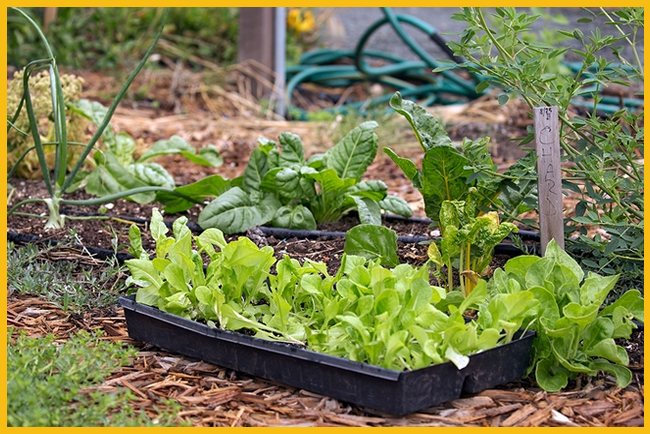How to Prepare for Spring Planting for a Bountiful Harvest of Summer Veggies

By Donna McClay
The secret to ensuring a successful summer vegetable garden is planning ahead. With winter in full swing, it’s not too early to plan for spring planting. Here is a simple step-by-step plan to help you make the most of your efforts to grow a robust summer vegetable garden.
What Do You want to Grow? Seed catalogs and online websites are abundant and can help you select the right varieties of vegetables for your location. For example, do I want to try heirloom tomatoes or stick to hybrid varieties that are disease-resistant? The variety you choose can mean the difference between a good yield or not. Most importantly, what do your household members like to eat? Tip: Kids are more likely to eat what they plant themselves, so let them participate in the selection and planting process to broaden their vegetable horizons. Joyce Gemmel’s Vegetable Planting Guide will help you decide what to plant: https://www.mastergardenersd.org/vegetable-planting-guide/. To take the guesswork out of planning for subsequent years, keep an annual journal of what varieties worked best and what didn’t.
Prep Your Tools. Garden tools and equipment are your best friends so treat them that way. Inspect your tools for signs of rust and dirt and follow the 3 S’s to keep them in good shape: Scrub – Sharpen – Sanitize. Here’s a complete guide to tool care and maintenance: https://www.mastergardenersd.org/garden-tool-care/. Most importantly, remember to disinfect your tools after using them to avoid spreading pests and diseases throughout the garden. Keep a can of disinfectant wipes in your garden shed for this purpose.
Begin Composting. Vegetable gardens need lots of organic material to encourage healthy growth, so save your grass clippings, vegetable and fruit scraps, dried leaves, and newspapers to start your own compost pile. Here is some information on how to compost at home: https://anrcatalog.ucanr.edu/pdf/8367.pdf
Start Seedlings. Some vegetables do best as transplants while others can be sown directly into the garden. Tomatoes, peppers, and eggplant do better as transplants while squash, cucumbers and corn can be planted as seeds. Be sure to start your seedlings so they reach optimum planting size by the time the beds are ready to be planted. It’s best to plant summer vegetables when the soil temperature reaches a minimum of 65 degrees F. Germination rates improve when seeds are sown in soil with temperatures between 65 and 75 degrees F.
Prep the Planting Beds. Both in-ground and raised beds produce better vegetable crops if they are properly prepared. That includes removing weeds and debris, and amending the soil with organic material in order to improve root structure and encourage healthy growth. Wait until the beds are moist (but not soaking wet) to make it easier to work the soil. If your beds are bone dry, then water deeply and wait a few days until the soil has had a chance to absorb water and become uniformly moist. Clean out roots, weeds, and other debris before amending. Compost is ideal for adding organics to soil. Other amendments include composted chicken manure, worm castings, and peat moss. A pre-emergent vegetable fertilizer is also recommended to add micronutrients to the soil. Raised beds may need some additional soil to replace the amount lost to previous watering and soil compaction.
Check and Repair Irrigation. Vegetable gardens do best with drip irrigation to reduce water waste and minimize the potential for molds and mildew to develop from overspray on leaves. Check your irrigation lines and emitters to ensure everything is in good working order, and repair and replace them as necessary. Check that your irrigation controller is working properly. Set the timer to water in the early morning or evening hours.
Create a Planting Plan. Each type of vegetable has its own unique requirements for space depending on its growth habits. Be sure to review the row and plant spacing requirements for what you are growing. For example, tomato plants need at least 18-24 inches of space around them to allow for sufficient air circulation and sunlight. Proper spacing reduces the chances of mold, mildew and other diseases taking hold of the plants. The strongest defense against pests and diseases is healthy plants, so do spend time to understand what each plant needs. Tomatoes, peas, and beans typically do best with some type of trellis, cage or staking, so make sure you allow sufficient room in your vegetable garden for plants to reach their mature size. Plan your garden so that vegetables with similar water requirements are grouped together.
Here are Helpful Additional Resources:
- Vince Lazaneo’s Vegetable Gardening Guides: https://www.mastergardenersd.org/wp-content/uploads/2016/12/Try-Vegetable-Gardening-Vince-Lazaneo-06.27.16.pdf
https://www.mastergardenerssandiego.org/Vegetable%20Planting%20Guide1.pdf
- Master Gardener Association of San Diego County’s Beginning Vegetable Gardening Information: https://www.mastergardenersd.org/beginning-vegetable-gardening/
- UC Integrated Pest Management Program Pest Notes for Vegetables: https://ipm.ucanr.edu/PMG/GARDEN/veggies.html
- Greg Alder’s Yard Posts Blog: https://gregalder.com/yardposts/starting-a-vegetable-garden-in-southern-california/
Donna McClay has been a UCCE Master Gardener since 2018 and became a UCCE Master Food Preserver in 2023. She enjoys educating the public on how to safely grow, harvest, and preserve vegetables grown in home gardens.

